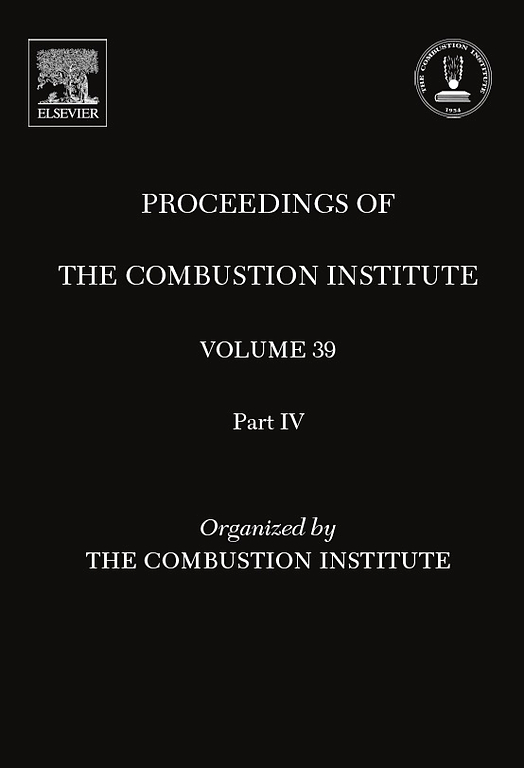人工加厚火焰方法在具有内在不稳定性的预混合氢火焰中的扩展
IF 5.3
2区 工程技术
Q2 ENERGY & FUELS
引用次数: 0
摘要
尽管人们对氢作为燃料的兴趣与日俱增,但目前的燃烧模型仍无法考虑火焰内在不稳定性的影响,如火焰表面积增大和局部分层。这对层流火焰的消耗速度产生了重大影响,使现有燃烧模型的转换变得更加复杂。本研究提出将人工增厚火焰(ATF)方法扩展到受内在不稳定性影响的层流自起皱火焰,作为推进湍流燃烧模型的基础。为了分析不稳定贫氢火焰中 ATF 和热扩散不稳定性的相互作用,进行了多次二维数值模拟。对特征长度尺度的评估显示,与增稠因子存在线性比例关系,导致不稳定性显现的域尺寸扩大,并改变了增稠火焰的消耗速度。为了弥补这些偏差,我们从火焰前沿的分形特征中推导出一种新的效率函数。将临界波长和几何长度尺度分别作为内部和外部截止点,在二维平面火焰的全耦合模拟中成功评估了改进的 ATF 模型。为便于使用新模型,提出并成功使用了一个实用的即时程序,用于估算效率函数所需的特征几何长度尺度。本文章由计算机程序翻译,如有差异,请以英文原文为准。
An extension of the artificially thickened flame approach for premixed hydrogen flames with intrinsic instabilities
Despite the growing interest in hydrogen as a fuel, current combustion models are still incapable of considering the effects of intrinsic flame instabilities, such as increased flame surface area and local stratification. A significant challenge arises due to the substantial impact on the laminar flame consumption speed, complicating the transfer of established combustion models. This study proposes an extension of the artificially thickened flame (ATF) approach to encompass laminar self-wrinkling flames subject to intrinsic instabilities, serving as a foundation for advancing turbulent combustion models. Several 2D numerical simulations were conducted to analyze the interaction of ATF and thermodiffusive instabilities in unstable lean hydrogen flames. The assessment of characteristic length scales revealed a linear scaling relationship with the thickening factor , causing the domain size at which instabilities manifest to expand and modify the consumption speed of the thickened flame. To compensate for these deviations, a novel efficiency function is derived from the fractal characteristics of the flame front. Using the critical wavelength and a geometric length scale as inner and outer cut-offs, respectively, the improved ATF model was evaluated successfully in fully coupled simulations of the 2D planar flames. To facilitate the use of the new model, a practical on-the-fly procedure for estimating a characteristic geometric length scale required for the efficiency function is proposed and successfully employed.
求助全文
通过发布文献求助,成功后即可免费获取论文全文。
去求助
来源期刊

Proceedings of the Combustion Institute
工程技术-工程:化工
CiteScore
7.00
自引率
0.00%
发文量
420
审稿时长
3.0 months
期刊介绍:
The Proceedings of the Combustion Institute contains forefront contributions in fundamentals and applications of combustion science. For more than 50 years, the Combustion Institute has served as the peak international society for dissemination of scientific and technical research in the combustion field. In addition to author submissions, the Proceedings of the Combustion Institute includes the Institute''s prestigious invited strategic and topical reviews that represent indispensable resources for emergent research in the field. All papers are subjected to rigorous peer review.
Research papers and invited topical reviews; Reaction Kinetics; Soot, PAH, and other large molecules; Diagnostics; Laminar Flames; Turbulent Flames; Heterogeneous Combustion; Spray and Droplet Combustion; Detonations, Explosions & Supersonic Combustion; Fire Research; Stationary Combustion Systems; IC Engine and Gas Turbine Combustion; New Technology Concepts
The electronic version of Proceedings of the Combustion Institute contains supplemental material such as reaction mechanisms, illustrating movies, and other data.
 求助内容:
求助内容: 应助结果提醒方式:
应助结果提醒方式:


